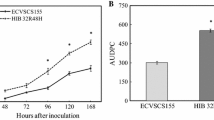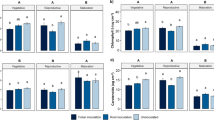Abstract
The possible role of the fusariotoxin, fusaproliferin in plant pathology was investigated with respect to cell membrane potential. Electron microscopy was used to study both the early effect of fusaproliferin on the host’s plasma membrane and ultrastructure responses in the cells of maize leaves. The seedlings of resistant (Lucia) and susceptible (Pavla) to the fusaproliferin maize cultivars were grown in the presence of fusaproliferin at different concentrations, namely 5 and 35 μg ml−1, respectively, and electrophysiological measurements were compared with those obtained using two different toxic compounds, namely fusicoccin and 3-3(3,4 dichlorophenyl)-1,1-dimethylurea (DCMU). It was observed that only the higher concentration of fusaproliferin induced the onset of visible symptoms on the leaves. Comparing the effect of fusaproliferin to that of fusicoccin and DCMU at the higher toxin concentration, it was observed that functional differences in membrane potential induced severe damage to the mesophyll and outer chloroplast membrane; the extent of changes in electrophysiology and ultrastructure disturbances depended on the toxin concentration and was greater in the susceptible cv. Pavla. Results indicated that fusaproliferin could be involved in Fusarium pathogenesis either as a virulence factor or by enhancing the activity of other toxins that might be concomitantly present in infected plants.




Similar content being viewed by others
References
Abbas, H. K., Boyette, C. D., Hoagland, R. E., & Vesonder, R. E. (1991). Bioherbicidal potential of F. moniliforme and its phytotoxin, fumonisin. Weed Science, 39, 673–677.
Adams, G. C., & Hart, L. P. (1989). The role of deoxynivalenol and 15-acetylated DON elucidated through protoplast fusions between toxigenic and nontoxigenic strains. Phytopathology, 79, 404–408.
Atanassov, Z., Nakamura, C., Mori, N., Kaneda, C., Kato, H., Jin, Y. Z., et al. (1994). Mycotoxin production and pathogenicity of Fusarium species and wheat resistance to Fusarium head blight. Canadian Journal of Botany, 72, 161–167.
Daly, J. M. (1981). Mechanism of action. In R. D. Durbin (Ed.), Toxins in plant disease (pp. 331–394). New York: Academic.
Dekov, I., Tsonev, T., & Yordanov, I. (2000). Effects of water stress and height temperature stress on the structure and activity of photosynthetic apparatus of Zea mays and Helianthus annuus. Photosynthetica, 38, 361–366.
Desjardins, A. E., & Hohn, T. M. (1997). Mycotoxins in plant pathogenesis. Molecular Plant-Microbe Interactions, 10, 147–152.
Duke, S. O., & Lydon, J. (1993). Natural phytotoxins as herbicides. In ACS Symposium Series N. 524, Pest control with enhanced environmental safety (pp. 110–124). Washington: ACS.
Farr, D. F., Bills, G. F., Chamuris, G. P., & Rossman, A. Y. (1989). Fungi on plants and leaves. Microbiology, 62, 3378–3384.
Gang, G., Miedaner, T., Schuhmacher, U., Schollenberger, M., & Geiger, H. (1998). Deoxynivalenol and nivalenol production by Fusarium culmorum isolates differing in aggressiveness toward winter rye. Phytopathology, 88, 879–884.
Glauert, A. (1975). Fixation, dehydration and embedding of biological specimens (p. 207). Amsterdam: North Holland.
Ilarsan, H., & Dolar, F. S. (2002). Histological and ultrastructural changes in leaves and stems of resistant and susceptible chickpea cultivars to Ascochyta rabiei. Journal of Phytopathology, 150, 340–348.
Kaup, M. T., Froese, C. D., & Thompson, J. E. (2002). A role for diacylglycerol acyltransferase during leaf senescence. Plant Physiology, 129, 1616–1626.
Lamprecht, S. C., Marasas, W. F. O., Alberts, J. F., Cawood, M. E., Gelderblom, W. C. A., Shepard, G. S., et al. (1994). Phytotoxicity of fumonisins and AAL – Toxin to corn and tomato. Phytopathology, 84, 383–391.
Logrieco, A., Moretti, A., Fornelli, F., Fogliano, V., Ritieni, A., Caiaffa, M., et al. (1996). Fusaproliferin production by Fusarium subglutinans and its toxicity to Artemia salina, SF-9 insect cells, and IARC/LCL 171 human B-lymphocytes. Applied Environment Microbiology, 62, 3378–3784.
Marre, E. (1980). Fusicoccin: Mechanism of action on electrogenic hydrogen ion extrusion. Developments in Plant Biology, 4, 227–243.
Miedaner, T., Schilling, A. G., & Geiger, H. H. (2001). Molecular genetic diversity and variation for aggressiveness in populations of Fusarium graminearum and Fusarium culmorum sampled from wheat fields in different countries. Journal of Phytopathology, 149, 641–648.
Monti, S. M., Fogliano, V., Logrieco, A., Ferracane, R., & Ritieni, A. (2000). Simultaneous determination of beauvericin, enniatins, and fusaproliferin by high performance liquid chromatography. Journal of Agricultural and Food Chemistry, 48, 3317–3320.
Munkvold, G. P. (2003). Cultural and genetic approaches to managing mycotoxins in maize. Annual Review of Phytopathology, 41, 99–116.
Nadubinská, M., Ritieni, A., Moretti, A., & Šrobárová, A. (2003). Chlorophyll content in maize plants after treatment with fusariotoxins. Biologia Bratislava, 58, 115–119.
Neuhold, G., Fidesser, M., & Krska, R. (1997). Head blight (Fusarium spp.) on wheat: investigation on the relationship between disease symptoms and mycotoxin content. Cereal Research Communications, 25, 459–465.
Novacky, A., & Ullrich-Eberius, C. I. (1982). Relationship between membrane potential and ATP level in Xanthomonas campestris pv. malvacearum infected cotton cotyledons. Physiological Plant Pathology, 21, 237–249.
Pascale, M., Visconti, A., & Chelkowski, J. (2002). Ear rot susceptibility and mycotoxin contamination of maize hybrids inoculated with Fusarium species under field conditions. European Journal of Plant Pathology, 108, 645–651.
Pavlovkin, J., Mistrík, I., & Prokop, M. (2004). Some aspects of the phytotoxic action of fusaric acid on primary Ricinus roots. Plant Soil Environment, 50, 397–401.
Pinto, S. R. C., Azevedo, J. L., Pereira, J. O., Vieira, M. L. C., & Labate, C. A. (2000). Symptomless infection of banana and maize by endophytic fungi impairs photosynthetic efficiency. New Phytologist, 147, 609–615.
Placinta, C. M., D’Mello, J. P. F., & Macdonald, A. M. C. (1999). A review of worldwide contamination of cereal grains and animal feed with Fusarium mycotoxins. Animal Feed Science and Technology, 78, 21–37.
Pocsfalvi, G., Ritieni, A., Randazzo, G., Dobo, A., & Malorni, A. (2000). Interaction of fusarium mycotoxins, fusaproliferin and fumonisin B1 with DNA studied by electrospray ionization mass spectrometry. Journal of Agricultural and Food Chemistry, 48, 5795–5801.
Proctor, R. H., Desjardins, A. E., McCormick, S. P., Plattner, R. D., Alexander, N. J., & Brown, D. W. (2002). Genetic analysis of the role of trichothecene and fumonisin mycotoxins in the virulence of Fusarium. European Journal of Plant Pathology, 108, 691–698.
Randazzo, G., Fogliano, V., Ritieni, A., Mannina, L., Rossi, E., Scarallo, A. et al. (1993). Proliferin, a new Sesterterpene from Fusarium proliferatum, Tetrahedron, 49, 10883–10896.
Ritieni, A., Fogliano, V., Randazzo, G., Scarallo, A., Logrieco, A., Moretti, A. et al. (1995). Isolation and characterization of fusaproliferin, a new toxic metabolite from Fusarium proliferatum. Natural Toxin, 3, 17–20.
Ritieni, A., Monti, S. M., Randazzo, G., Logrieco, A., Moretti, A., Peluso, G. et al. (1997). Teratogenic effects of fusaproliferin on chicken. Journal of Agricultural and Food Chemistry, 45, 3039–3043.
Santini, A., Ritieni, A., Fogliano, V., Randazzo, G., Mannina, L., Logrieco, A. et al. (1996). Structure and absolute stereochemistry of fusaproliferin, a toxic metabolite from Fusarium proliferatum. Journal of Natural Production, 59, 109–112.
Shi, J., Mueller, W. C., & Beckman, C. (1991). Ultrastructure and histochemistry of lipoidal droplets in vessel contact cells and adjacent parenchyma cells in cotton plants infected by Fusarium oxysporum f.sp. vasinfectum. Physiological and Molecular Plant Pathology, 39, 201–211.
Stoyanova, D., & Uzunova, A. (2001). Effects of salicylic acid on the structure of second leaves of Hordeum vulgare, L. Biology of Plants, 44, 219–224.
Šrobárová, A., Nadubinská, M., & Čiamporová, M. (2004). Relative efficacy of fusariotoxins on young maize plants. Cereal Research Communications, 2, 241–248.
Vianello, M., & Macri, F. (1978). Inhibition of plant cell membrane transport phenomena induced by zearalenone. Planta, 143, 51–57.
Wang, Y. Z., & Miller, J. D. (1988). Effects of Fusarium graminearum metabolites on wheat tissue in relation to Fusarium head blight resistance. Journal of Phytopathology, 122, 118–125.
Zonno, M. C., & Vurro, M. (1999). Effect of fungal toxins on germination of Striga hermonthica seeds. Weed Research, 39, 15–30.
Acknowledgement
This work was supported by Slovak Grant Agency VEGA, Project No.2/3051/25, 2/6056/26 and SAS/CNR cooperation.
Author information
Authors and Affiliations
Corresponding author
Rights and permissions
About this article
Cite this article
Santini, A., Šrobárová, A., Pavlovkin, J. et al. Fusaproliferin effects on the photosystem in the cells of maize seedling leaves. Eur J Plant Pathol 120, 363–371 (2008). https://doi.org/10.1007/s10658-007-9226-5
Received:
Accepted:
Published:
Issue Date:
DOI: https://doi.org/10.1007/s10658-007-9226-5




